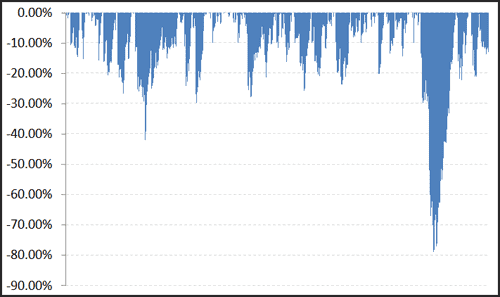Drawdown Diagnosis – what’s wrong with my trading?

Drawdown diagnosis – aren’t all drawdowns the same? After all, a loss is a loss, right? Wrong. Not all drawdowns are equal.
A drawdown is a decline in your trading account or strategy. Handling a drawdown is one of the hardest thing for traders (alongside sticking with their strategy).
Analysing Drawdown
I came across a great article (link no longer available) the other day written by Brett Steenbarger. I thought it important to share because one of the biggest stumbling blocks for new traders is coping when their account goes into drawdown. Drawdown is inevitable.
When you experience a drawdown in your profitability, the most important thing you can do is accurately diagnose what is going on. There are three possibilities:
Nothing is going on – The drawdown is normal and expectable for you and your trading approach. Unless you have an insanely high Sharpe ratio historically (steady gains, modest losses), you can count on sequences of losing trades and losing days, weeks, and months. You don’t want to overreact to every losing period and continually change what you’re doing; otherwise, you’d never build expertise in any particular trading modality
[NR comment: this is the big one. Drawdown is inevitable. Every great trader has had them and will continue to have them. If Warren Buffett has them, then you should expect to as well. You need to get comfortable with being uncomfortable].
Markets have changed – This is clearest when you identify shifts in market trends, volatility, and correlation over the period of your drawdown. A recent Bloomberg article in which I was quoted makes this point very well: young traders have not lived through rising rate regimes and could be surprised by changing market patterns (such as the correlation of stock and bond returns). If your drawdown correlates with such a period of market change, some adaptation is in order. Not all trading problems are psychological in origin.
[NR comment: It’s important to understand WHY your strategy makes money. The more you understand WHY, the more equipped you will be to deal with drawdowns when they come along]
You are trading poorly – A dominant theme in my forthcoming book is the importance of knowing your best practices. If you know what you do well when you are making money, you’re most likely to be able to identify when you deviate from those strengths. Poor trading can result from distraction, fatigue, frustration, and/or patterns of negative self-talk. Until you address those factors, putting capital at risk undermines your trading business.
[NR comment: This is certainly a key point for discretionary traders. However, having a tested systematic approach can keep you on the right track longer. When in the drawdown wilderness it pays to have a map]
Markets continually challenge us, and that is what prods us to continually change. Drawdowns are the market’s way of telling us that we need to focus on our trading and not on screens. Some of the greatest and most constructive changes in people’s trading have been inspired by the most painful losses.

